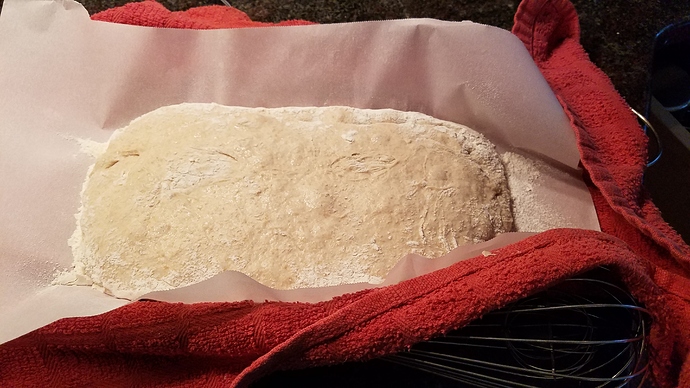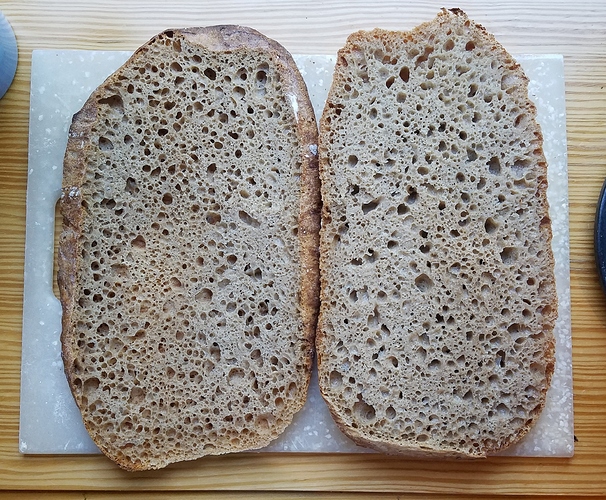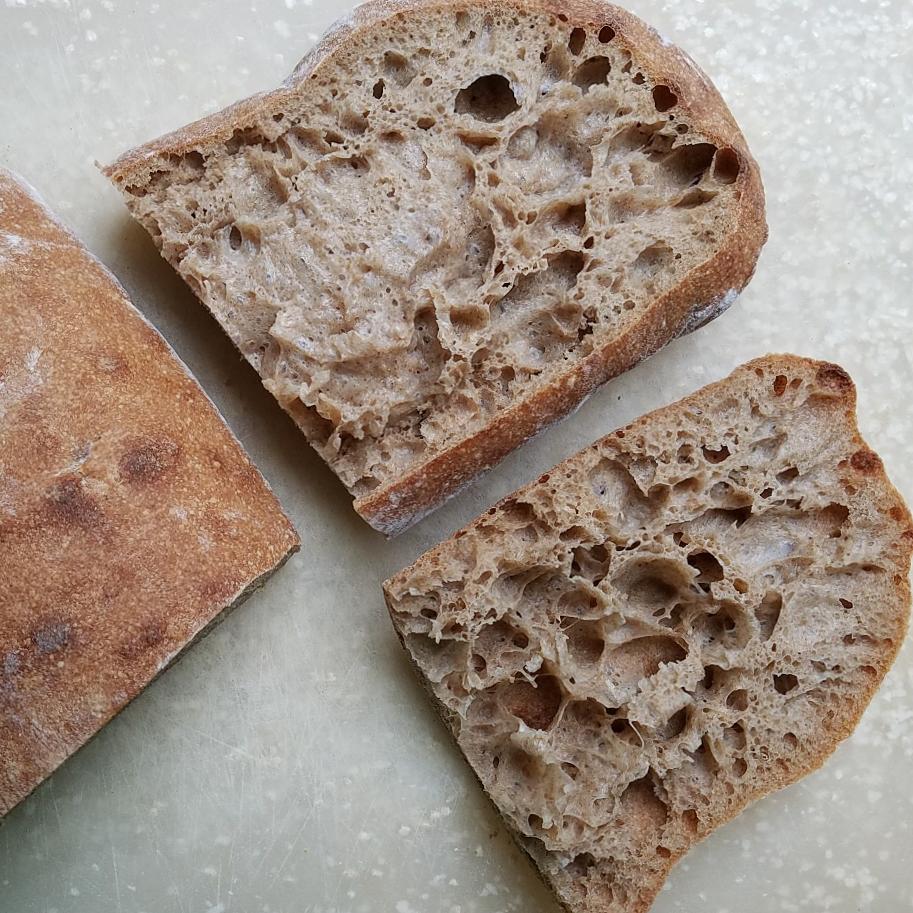This is the comment thread for the Breadtopia blog post originally published here:
Ciabatta is one of my favorite kinds of bread but I’ve had limited success making it. I’m anxious to try Melissa’s recipe but there’s one problem. My wife won’t eat sourdough bread. Is there a way to adapt it perhaps by using a poolish instead of sourdough starter?
Thanks for any suggestions.
Hi, Melissa, this looks great! I have an overabundance of whole grain flour at the moment and would love to use it to try your ciabatta recipe. Have you tried making ciabatta using all or part whole wheat flour? Any suggestions? Thanks!
I don’t think this sourdough ciabatta is very sour, so my first suggestion would be to try it, making sure you use all purpose flour starter. But I think my starter doesn’t make sour bread in general, so this could be risky 
I’m on the road so I can’t test the following recipe …but here goes:
poolish (you’ll have 10g to spare)
300g water
260g all purpose flour
1/4 tsp active dry yeast
Leave out for 6-24 hrs, less time = less sour, should triple in size.
Add poolish to the dough ingredients from the sourdough ciabatta (withholding 75g water until after hand mixing) and with the addition of:
1 tsp of active dry yeast
Hand mix or machine mix as described above.
Cover and let rise 1 - 1.5 hrs (until doubled)
Shape and prep for proof same as above.
Let proof for 1-2 hrs or until puffier.
Bake same as sourdough ciabatta above.
I hope this helps! Let me know how it turns out. I’ll aim to try it soon.
I’m totally planning to try this soon. Maybe next week.
My tips without experience (for what that is worth) would be to autolyse the whole grain flour and water for an hour or more. My starter doubles in 3-4 hours so I might build the starter and autolyse the whole grain flour and water (minus 75g water, salt and oil) at the same time. Then combine autolyse dough with salt and oil and starter. Mix. Add 75g or more water…
…Maybe add a little more water to the recipe, based on the idea that the whole grain flour may be thirstier. Look at the gallery pics to see how wet the dough is.
I hope it works out well. I’d love to see crumb pics and hear how it goes. I think the hydration, mixing, and shaping techniques will transfer to partial whole grain.
Thanks so much Melissa. I’ll give it a try.
I thought of something last night. The poolish I suggest is high enough hydration, you probably won’t get tripling. Go with time and bubbles, rather than expansion.
Will do.
Wendy,
I tried making a part whole grain ciabatta today. I used spelt flour and AP starter. My autolyse was 4 hrs. I needed more water to moisten the flour so I used some of that 75g (40g)
After the autolyse, I added in the starter, salt, and oil. The dough was wet and already nicely gluteny from the autolyse, but I still mixed it for 3-4 min. I then added the remaining water from that 75g (35g). This made the dough crazy wet. Then I overproofed it.
Next time, I’m going to not add that last 35 g of water and I’ll go less than 4 hrs on the bulk unless my house gets colder.
Have you made a whole grain ciabatta yet?
Edited to add a crumb photo and “proofing a super wet and less gluten dough” strategy. Note the whisks providing walls to the makeshift couche.
The crumb of the ciabatta is actually pretty good for the amount of whole grain flour in the dough, but in transferring to the stone, I tried to flip the slipper and ended up with a violent bubble-popping smack onto the peel and parchment paper on both sides of the slipper. This made for a sad crust.
Thinking on it more, I might keep all the water, but simply lift the parchment into the oven after proofing (no flip).
Thanks, Melissa, this is great! I so appreciate you trying a whole grain version and posting your notes and photo. I haven’t tried it yet, I got distracted by testing a fougasse recipe for an upcoming party.
I want to make sure I understand what you did. Did you use 550g of whole spelt flour in place of the 550 g of bread flour in your original formula and 500g of AP flour starter?
I feel your pain in transferring the dough. It is such a bummer to spend all the time babying the dough and then mess up getting it into the oven. Been there, done that. I like the idea of just sliding the parchment into the oven without flipping.
I will give this a try and let you know.
Ooh fougasse - I have to try one soon. I hope yours turned out well for your party.
I actually halved the ciabatta recipe when doing the whole grain spelt, but in the interest of not being confusing, I’ll pretend I didn’t  I used:
I used:
550g whole grain spelt flour
550g AP starter (I’d estimate that 300g of this is water and 250g is AP flour)
Great, thanks! I actually plan to halve the recipe when I try it too.
Yes, I was really pleased with the fougasse. I used a recipe from King Arthur Flour. It looked very impressive, but was actually pretty easy and forgiving. Just took a little attention to cut it.
Here are some notes and pics from round two…
Auto
275g whole grain conventional wheat
200g water
Build
275g all purpose flour starter ~120% hydration
Combine auto, build and
1 Tbsp olive oil
1 rounded tsp salt
Mix until windowpane-ish
3 stretch and folds
4 hr total bulk
2 hr proof in fridge
Transfer parchment to oven without flipping.
I got a better crumb but the oven spring was violent and tore thru the bran-y gluten, making for lots of holes on the upper half of the loaf. I don’t know if this was because of the cold proof, the lack of dough flipping or the amount of bran.
Still better than the last one 
Thanks for the fougasse info - I’ll look up the KA recipe.
Wow! This looks impressive for so much whole grain! I’m going to try it for my next bake. I’ll let you know how it goes. Can’t wait!
King Arthur has several fougasse recipes. The one I tried was the Olive and Onion Fougasse which uses a poolish, not sourdough. I followed it exactly except that I had only 45g of olives rather than the 106g called for and I eliminated the onions which I don’t like and added some chopped rosemary. The 45g of olives, which I quartered, seemed fine to me. Since this test was just for me, after it came out of the oven, I brushed half of it with olive oil, then sprinkled with coarse salt. I liked that effect a lot, but it made the bread quite salty, so next time, I’ll cut back on some of the salt in the recipe so I can sprinkle the surface.
I haven’t made a recipe with commercial yeast for quite a while, so I was surprised at the strong yeast flavor. I’ll try making it again some time with an overnight sourdough fermentation.
Olive and rosemary is so good  Thanks for the details! (The same salt thing happened to me with garlic knots a few months ago.)
Thanks for the details! (The same salt thing happened to me with garlic knots a few months ago.)
I’ve finally tried a ciabatta and it went quite well. I followed your round 2 directions pretty closely, using whole grain white wheat. The only changes that I made were to make a 100% hydration starter and add the extra 25g of water to the final mix. I did this just because that’s what my starter is and I’m used to how it acts. It came out quite well with lots of lovely holes. It was a little too flat but because there was no spread in the oven, there was good oven spring, and there were plenty of holes, I’m pretty sure that I just stretched it too much. It was huge!
I did manage to flip it. Because I only made one loaf, I proofed it on a floured cotton tea towel on top of a small baking tray. When it was ready to put on the peel, I put a long sheet of parchment over the tray, holding it down at the ends and flipped it quickly onto the peel. It worked out quite well.
An odd note: The only starter I use is a whole spelt starter, so I began the starter with 5g of this and did all the feeds with white AP flour. Unlike my usual spelt starter which more than doubles when I feed it, the AP starter never doubled. Although it got quite bubbly, it never increased more than 50% before starting to collapse. I’ve read that switching to a different grain type can adversely affect a starter and take some time to recover. Have you ever had this experience? Next time I may trying flipping things around, making a whole spelt starter and adding the AP flour to the mix and see how that works.
Thanks so much for all your recipes and experimentation. Your detailed notes and photos take some of the mystery and confusion out of the process and really inspire!
I’m so glad your ciabatta turned out well! Keeping your starter hydration to what you’re used to and then adding water was a great idea. I don’t have a lot of experience converting flour types in my starter, but I’d heard what you had heard about recovery and adjustment. Let me know how your ciabatta with spelt starter with AP and spelt flour in the dough turns out. I think that would be perfectly fine and less work for you, which is of course better than fine 
I’ve really enjoyed the ciabatta, the flavor is good and it’s remained remarkably moist for several days.
I have to add a footnote to my fougasse attempts. I made 2 of them again this weekend. They turned out quite well, but upon second tasting, I was disappointed. The flavor of the commercial yeast is overwhelming and the texture is odd, not exactly dry, but sort of stiff and not resilient. I found a Paul Hollywood recipe using sourdough, so I’m making a version of that as I write this. It’s so much fun to make, I hope this version will be better.
I hope the sourdough fougasse turned out well!
Unfortunately, it wasn’t great. The flavor was pretty good, but it didn’t rise much, the crust was actually hard and crunchy. I’ll keep plugging away and let you know if I come up with one I like.
I’m making your ciabatta recipe again this weekend, this time as rolls.


